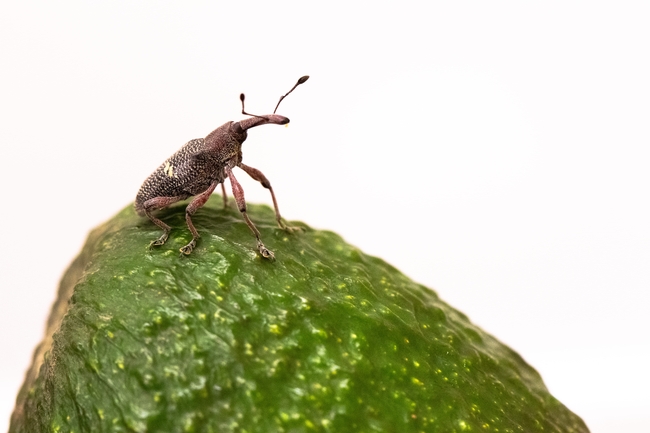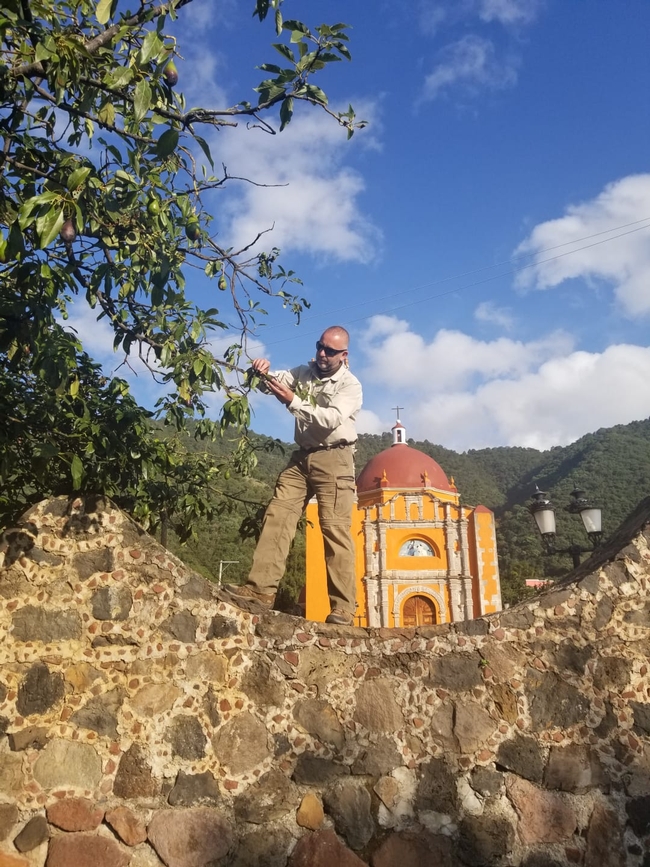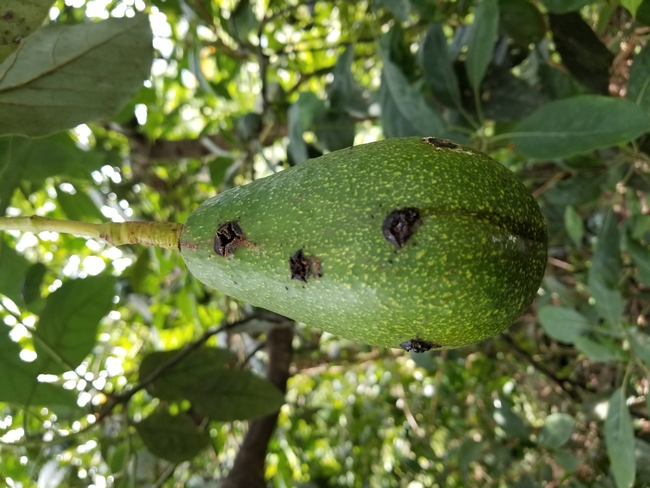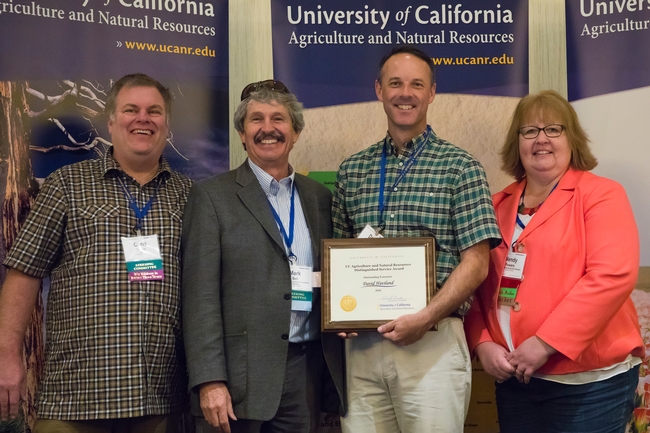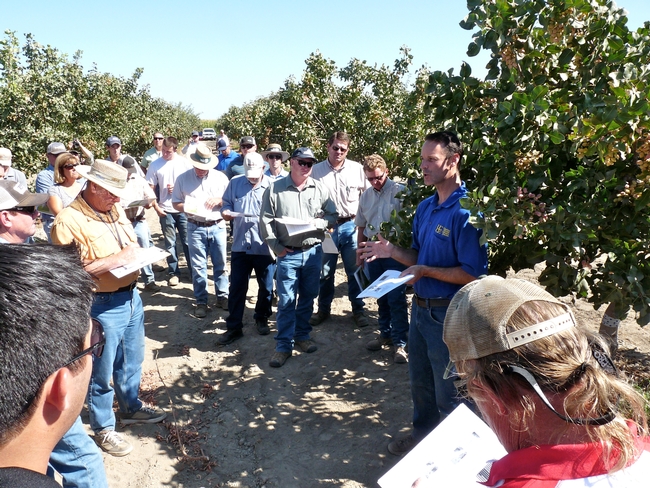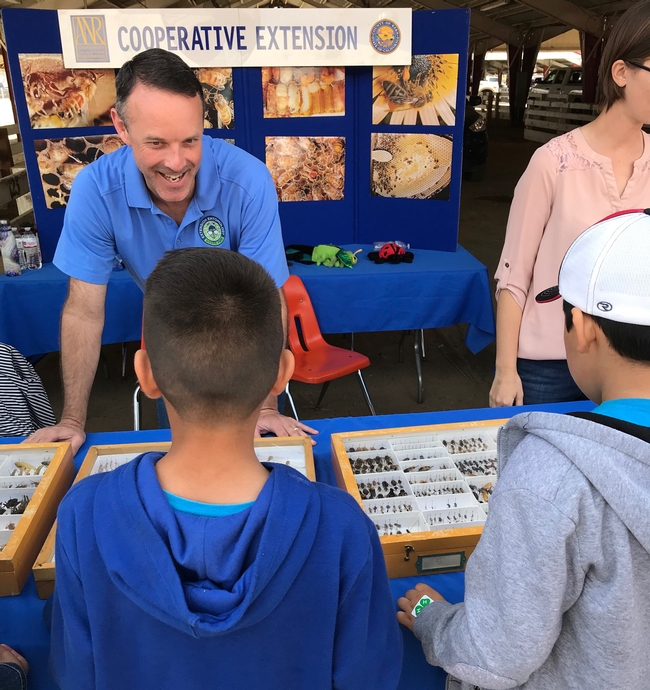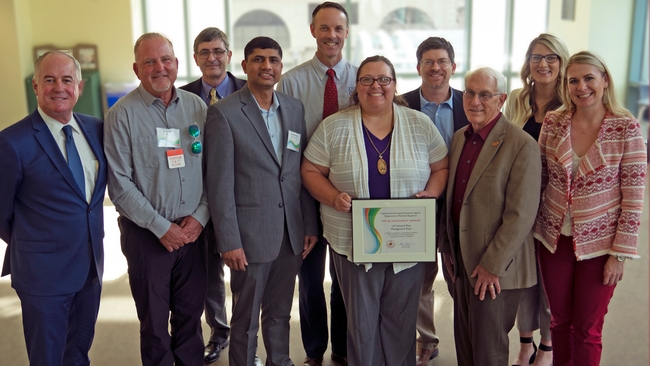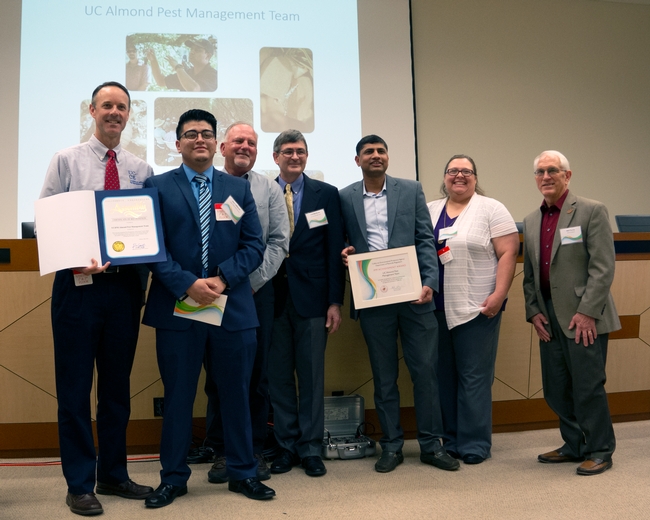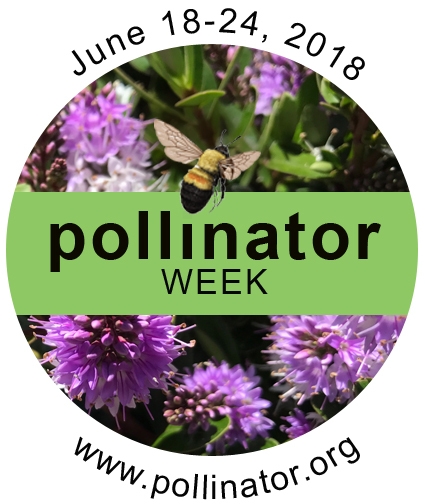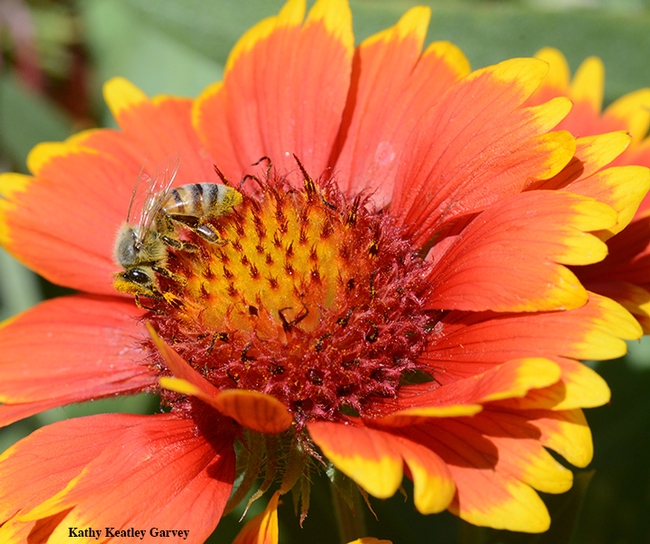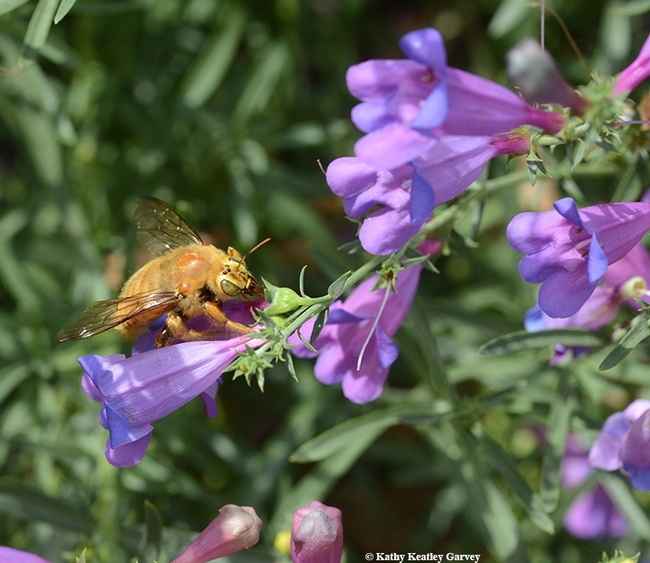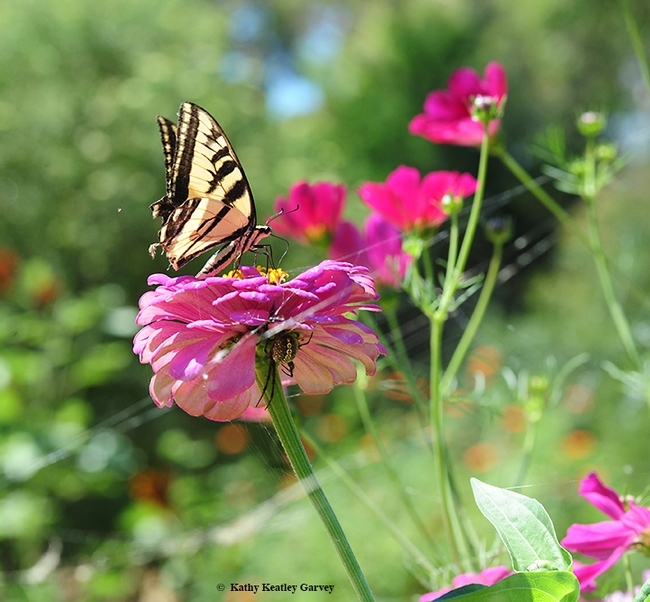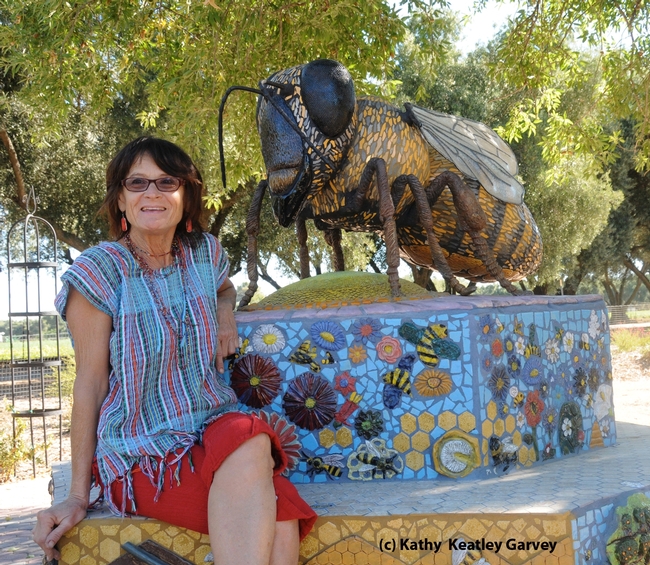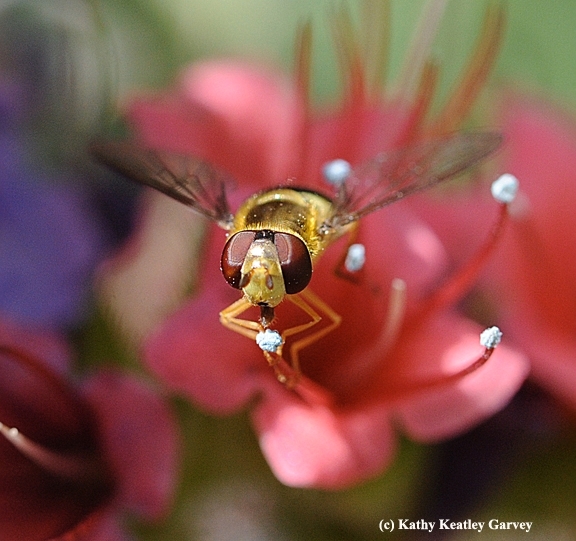Posts Tagged: entomology
The scent that could save California’s avocados
Scientists search for pheromone to disrupt insect mating
UC Riverside scientists are on the hunt for a chemical that disrupts “evil” weevils' mating and could prevent them from destroying California's supply of avocados.
Avocado weevils, small beetles with long snouts, drill through fruit to lay eggs. The weevil grubs or larvae bore into avocado seeds to feed, rendering everyone's favorite toast topping inedible.
“They're extremely hard to control because they spend most of their time deep inside the fruit, where they're very well protected from insecticides and natural enemies,” said UCR researcher Mark Hoddle, a UC Cooperative Extension entomology specialist.
Not only are the insects reclusive, they are also understudied, making information about them hard to come by. “All books on avocado pest management will tell you these weevils are bad. They're well recognized, serious pests of avocados, but we know practically nothing about them,” Hoddle said.
One strategy for controlling pests is to introduce other insects that feed on them. However, that is unlikely to work in this case. “Natural enemies of these weevils seem to be extremely rare in areas where this pest is native,” Hoddle said.
To combat avocado weevils in Mexico, an area where they are native, and to prevent them from being accidentally introduced into California, Hoddle is working with Jocelyn Millar, a UCR insect pheromone expert. They are leading an effort to find the weevil's pheromone, with the goal of using it to monitor these pests and prevent them from mating in avocado orchards.
Pheromones are chemicals produced and released into the environment by an insect that can be “smelled” by others of its species, and affect their behavior.
“We could flood avocado orchards with so much pheromone that males and females can't find each other, and therefore can't reproduce,” Hoddle said. “This would reduce damage to fruit and enable growers to use less insecticides.”
Alternative control strategies could include mass trapping, using the pheromone as a lure, or an “attract-and-kill” approach, where the pheromone attracts the weevils to small sources of insecticide.
The work to identify, synthesize and test this pheromone in the field is supported by grants from the California Department of Food and Agriculture, as well as the California Avocado Commission.
An initial phase of the project sent Hoddle to a base of operations three hours south of Mexico City, an area with large weevil populations. Using a special permit issued by the USDA, Hoddle brought weevils back to UCR's Insectary and Quarantine facility.
Hoddle and Sean Halloran, a UCR entomology researcher, captured the chemicals that avocado weevils release into the air. Possible pheromone compound formulas were identified from these crude extracts and are now being synthesized in Millar's laboratory.
“Weevil pheromones have complicated structures. When they're made in a lab, they can have left- or right-handed forms,” said Hoddle. Initially, Millar's group made a mixture of both forms to see if the blend would work as an attractant, as it is far cheaper to make the blend than the individual left- or right-handed forms.
Field work in Mexico with the pheromone cocktail by Hoddle, his wife Christina Hoddle, an associate specialist in entomology, and Mexican collaborators did not get a big response from the weevils, suggesting that one of the forms in the blend could be antagonizing the response to the other.
As the next step, the researchers plan to synthesize the individual forms of the chemicals and test the insects' response to each in Mexican avocado orchards.
Because the levels of avocado imports from Mexico are increasing, the risk of an accidental weevil invasion is rising as well. Hoddle is hopeful that the pheromone will be successfully identified and used to lower the risk this pest presents to California's avocado growers.
“We've been fortunate enough to be awarded these grants, so our work can be implemented in Mexico and benefit California at the same time,” Hoddle said. “The tools we develop now can be used to make sure crops from any exporting country are much safer to import into California.”
Entomologist’s work benefits Kern County agriculture
This is the fourth in a series featuring a few scientists whose work exemplifies UC ANR's public value for California.
UC Cooperative Extension entomology advisor David Haviland has been recognized by his peers, his clientele, and extension directors who oversee programs in 14 western U.S. states. It's a Cooperative Extension hat trick unusual among UCCE mid-career professionals.
“The combination of three awards for me is an incredible honor because I know there are a lot of good extension programs out there,” Haviland said.
In July 2019, Haviland accepted an Award of Excellence from the Western Extension Directors Association (WEDA) on behalf of a team of scientists and commodity representatives. In 2018, he received a Distinguished Service Award for Excellence in Extension from UC Agriculture and Natural Resources, UCCE's parent organization, and the Pacific Branch Entomological Society of America honored him with an award for Excellence in Extension.
In addition, Haviland just completed a two-year term as president of the Association of Applied IPM Ecologists.“This is a professional society for growers and pest control advisers who are advocates of integrated pest management,” Haviland said. “I was elected president of an association of my clientele, the people I'm here to serve.”
While Haviland is providing pest management solutions for farmers, he is also adding to UC Cooperative Extension's value to the community of Kern County and California. For example, after two years of research and extension in almond pest management, pest control advisors who participated in one or more of Haviland's activities reported a 25% increase in using a new ‘green' technology called mating disruption for navel orangeworm control. Mating disruption reduces pesticide use, helping to safeguard an abundant and healthy food supply.
When spotted wing drosophila invaded the southern San Joaquin Valley, cherry growers lost tens of millions of dollars. Haviland responded by developing field data on pest phenology, chemical controls, and the effects of pesticide degradation of the efficacy of control programs. He combined this information into guidelines that he taught to cherry growers. Using these guidelines saves cherry growers in Kern County millions of dollars in averted losses annually, promoting more economic prosperity in the region.
Haviland devoted his career to UCCE. After a two-year mission in Buenos Aires, where he learned to speak Spanish fluently, and a bachelor's degree in zoology at Brigham Young University, the Salinas native joined UC Cooperative Extension as an agricultural assistant at the Monterey County office in 1997. There he worked with academics in entomology, plant pathology, weed science, soil science and viticulture.
“Before that job, I wasn't clear what UCCE was,” he said. “I was shocked that there was such a thing as a career that allowed you to study insects, work in agriculture, do research, teach and get paid for it. All those things fascinated me and were part of my skill set.”
Knowing that a farm advisor position requires a master's degree, he moved with his family to Davis, where he undertook coursework in plant protection and pest management. During his last semester, a unique position at UC Cooperative Extension became available. Haviland applied and was offered the position as the Kern County entomology advisor affiliated with the UC Statewide Integrated Pest Management Program. He began work in Bakersfield the day after his master's thesis was signed in July 2002.
“I was really excited for the job,” Haviland said. “I was excited to be a farm advisor in a big agricultural county. And also, the Statewide IPM Program gave me a peer group in entomology to help me early in my career. That was invaluable.”
The 2019 WEDA award recognized teams that were assembled over 15 years to help Kern County growers respond to invasive pests that were threatening California agriculture. Teams were created to address a variety of pests, each requiring a different expertise.
“For spotted wing drosophila in cherries, we needed entomologists and a pomologist. For sharpshooters in grapes, mealybugs in pistachios and navel orangeworm in almonds we responded using teams of commodity advisors, IPM advisors, UC specialists and industry stakeholders, including commodity boards,” Haviland said. “We also formed a team to train farm labor contractors about pesticide drift so they could train fieldworkers on how to be safe at work.”
Haviland is also active in the Almond Pest Management Alliance Team, which received the 2019 California Department of Pesticide Regulation (CDPR) Integrated Pest Management Achievement Award. For more than a decade, the team conducted research on navel orangeworm, spider mites, leaffooted bug and ants that laid the groundwork for IPM adoption. For the past three years, they put these IPM practices on display using eight demonstration orchards across the San Joaquin Valley as part of a CDPR Pest Management Alliance Grant.
In teaching farm labor contractors, and in other capacities throughout his career, Haviland said his Spanish fluency has been an excellent tool.
“People who work in the agricultural industry are most likely to find Spanish-speaking field workers,” he said. “Instead of training supervisors in English, and having them translate materials, we are training workers in their own language so they can be as proficient as possible.”
Now that he is in the second half of his career, Haviland said he is serving as a mentor to new advisors, providing knowledge and support that were so important to him when he was first hired.
“I had some fabulous mentors who did everything in their power to give me a quick start to my career,” he said. “Now it's time to do my part.”
For the past two years, Haviland has worked with young entomology advisors by creating a pest management alliance project that secured funding for large-scale regional almond projects across the Central Valley. These types of projects provide funding and support that can launch new advisors into successful careers.
National Pollinator Week: Open house at UC Davis Bee Garden
June 18-24 is National Pollinator Week.
Do you know where your pollinators are? Think bees, birds, butterflies, bats and beetles.
And think flies. Especially syrphid flies, also known as "flower flies" and "hover flies."
The UC Davis Department of Entomology and Nematology is hosting an open house during National Pollinator Week from 11 a.m. to 2 p.m. at its bee garden, Häagen-Dazs Honey Bee Haven on Bee Biology Road, west of the central UC Davis campus.
Here's what you can expect to see or do:
- learn how to catch and observe bees up close
- see honey bees at work in an observation beehive
- learn about bee diversity and identification
- learn about what and how to plant for bees
- learn about growing and good pollination in home fruit gardens
- see easy-to-grow bee plants and solitary bee houses available for a donation to the garden.
The Häagen-Dazs Honey Bee Haven, installed in the fall of 2009 and located next to the Harry H. Laidlaw Jr. Honey Bee Research Facility on Bee Biology Road, off Hopkins Road, is a half-acre garden devoted to bee pollinator conservation and education. It was founded and sprang to life during the term of interim department chair, Professor Lynn Kimsey, director of the Bohart Museum of Entomology, who coordinated the entire project. Kimsey was singled out for her work when the Pacific Branch of the Entomological Society of America honored her and four others – "The Bee Team"– with the 2013 outstanding team award.
A Sausalito team – landscape architects Donald Sibbett and Ann F. Baker, interpretative planner Jessica Brainard and exhibit designer Chika Kurotaki – won the design competition. The judges were Professor Kimsey; founding garden manager Missy Borel (now Missy Borel Gable), then of the California Center for Urban Horticulture; David Fujino, executive director, California Center for Urban Horticulture at UC Davis; Aaron Majors, construction department manager, Cagwin & Dorward Landscape Contractors, based in Novato; Diane McIntyre, senior public relations manager, Häagen-Dazs ice cream; Heath Schenker, professor of environmental design, UC Davis; Jacob Voit, sustainability manager and construction project manager, Cagwin and Dorward Landscape Contractors; and Kathy Keatley Garvey, communications specialist, UC Davis Department of Entomology and Nematology.
Others with a key role in the founding and "look" of the garden included the UC Davis Art/Science Fusion Program, founded and directed by the duo of entomologist/artist Diane Ullman, professor and former chair of the UC Davis Department of Entomology, and self-described "rock artist" Donna Billick of Davis. Miss Bee Haven, a six-foot long worker bee sculpture, the work of Billick, anchors the garden. The art in the garden is the work of their students, ranging from those in Entomology 1 class to community residents. Eagle Scout Derek Tully planned, organized and built a state-of-the-art fence around the garden.
Why are pollinators so crucial? Take it from the Xerces Society for Invertebrate Conservation:
"Pollinators are essential to our environment. The ecological service they provide is necessary for the reproduction of over 85 percent of the world's flowering plants, including more than two-thirds of the world's crop species. The United States alone grows more than 100 crops that either need or benefit from pollinators, and the economic value of these native pollinators is estimated at $3 billion per year in the U.S. Beyond agriculture, pollinators are keystone species in most terrestrial ecosystems. Fruits and seeds derived from insect pollination are a major part of the diet of approximately 25 percent of all birds, and of mammals ranging from red-backed voles to grizzly bears. In many places, the essential service of pollination is at risk from habitat loss, pesticide use, and introduced diseases."
So, on Saturday, June 23, you won't see any red-backed voles or grizzly bears. But you'll see bees, butterflies, birds and beetles.
And flies. Syprhid flies.
For more information on the open house, access https://hhbhgarden.ucdavis.edu/wp-content/uploads/2018/01/Pollinator-week-flyer-2018-1.pdf
What's that in your cornmeal?
You're thinking about making Grandma's Southern Cornbread.
You head for your pantry. You remember that six months ago you purchased a bag of cornmeal from a local supermarket and that you immediately emptied the contents into a glass jar with a tight-fitting lid.
You open the airtight jar and notice something strange. It's moving. Moving? Moving? Yes! It's crawling with a transparent carpet of dozens of nearly microscopic critters.
What? First, what are they? If you're like me, you grab your camera--in this case, a Canon EOS 7D with an MPE-65mm lens that can magnify an insect five times its life size--and click the shutter.
You post the photo on BugGuide.Net and request an identification.
The entomologists all agree: They're booklice, Liposcelis bostrychophila.
- Class Insecta (Insects)
- Order Psocodea (Barklice, Booklice, and Parasitic Lice)
- Suborder Troctomorpha
- Family Liposcelididae (Booklice)
- Genus Liposcelis
- Species bostrychophila (Booklouse)
These Liposcelis bostrychophila, or "psocids" (pronounced "so kids"), are common pests in stored grains. They're usually unseen because they're about a millimeter long--about the size of a speck of dust--and are transparent to light brown in color. They're also wingless, but can they ever crawl!
Fact is, their name, "lice," is misleading. These tiny insects are not lice; they are not parasitic. And they're everywhere. They feed on flour, cereals, grits, molds, fungi, papers, books, pollen, dead insects and the like. In fact, you've probably unknowingly eaten them--or parts of them--in your pancakes, your oatmeal or maybe even your chocolate birthday cake.
Entomologist Jeff Smith, who curates the butterfly-moth collection at the Bohart Museum of Entomology at UC Davis, took one look at the photo and commented: "They're pretty thick in there!"
"Booklice can be scavengers and often feed on the bits of mold or fungi that grow on damp materials," Smith explained. "Very old, neglected food stuffs are also subject to them, and the key to prevention is to use food materials reasonably quickly and not store them for years, store them in a nice dry location and in airtight containers."
"They very well could have been in the food already when you bought it, but they're so common that you probably have some roaming around in the house all the time, just looking for something good to eat. They'll feed on dead bugs in window sills, stale pet foods, etc."
If you're worried about what's in your cornmeal, flour, oats, biscuit mix, cake mix and other stored foods, you can pop the contents in your oven at about 120° for a half hour, and then transfer them to an airtight container, Smith says. "Your food should be okay--albeit perhaps containing a few dead booklice. We had them in an old bag (paper) of rice one time, and in several packages of cornmeal mix that were forgotten in the back of our cupboard."
A UC Davis colleague said he's seen them crawling in his flour, but his wife made pancakes from them anyway. No issues. No problem. "Just protein!" he chortled.
And from another colleague: "I once had an entire case of instant grits. The grits were completely factory-sealed in unopened plastic bags. I opened the bags and the grits were poured into hot water, but they would not sink and mix with the water. Instead the grit floated on the top of the water. I opened a second bag and looked at the grits under my stereo microscope. Each and every grain of grit had two or three little six-legged creatures standing on each grit. These creatures were 100 percent transparent, the only color was in their bodies which was the same color as the grits they were eating. I opened every 100 percent factory-sealed bag, and every bag was contaminated in this matter."
"There is nothing new about insect contamination of grain products," she added. "Another personal experience was a biscuit mix. For no particular reason, I sifted the biscuit mix while making the batch of biscuits. After sifting several cups of biscuit mix, in the sifter screen there were 4 worm-like creatures about the diameter of a standard pencil and about an inch long. These worms were 100 percent transparent, each filled with the white biscuit mix. "Consider we all eat insects, spiders, and urine and feces of all sorts of animals."
We live in world where we all eat bugs, whether we know it or not. Sometimes we may not want to know!
Statistics indicate that the average American unknowingly eats one to two pounds of insects a year. But the U.S. Food and Drug Administration "has very specific tolerances for the amount of residue in food stuffs," said Lynn Kimsey, director of the Bohart Museum of Entomology and professor of entomology at UC Davis.
Want to know what the action level is? Check out this FDA document.
And the next time, you're yearning to make Grandma's Southern Cornbread, you might want to check for bugs first. Or maybe not. You might not want to know!
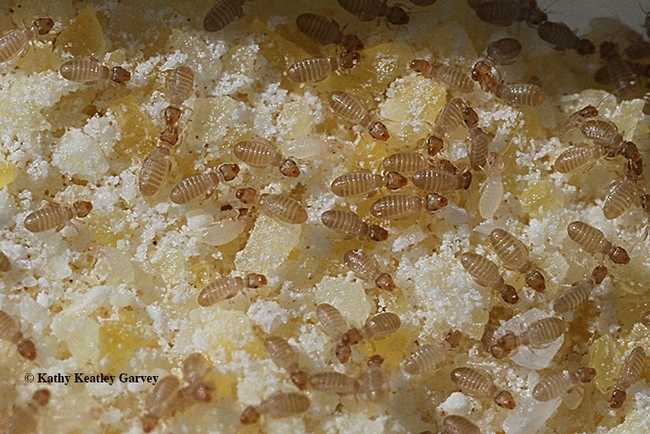
This image, taken with a Canon MPE-65mm lens, shows booklice, nearly microcopic insects, in cornmeal. The insects are about 1 millimeter long, or about the size of a speck of dust. (Photo by Kathy Keatley Garvey)
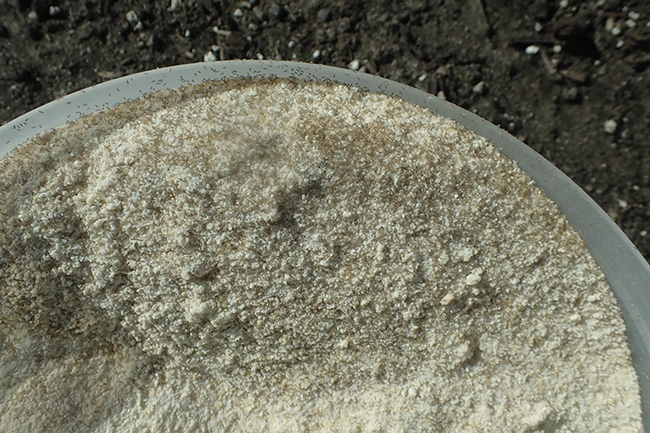
With the naked eye, booklice or Liposcelis bostrychophila, are nearly invisible. (Photo by Kathy Keatley Garvey)
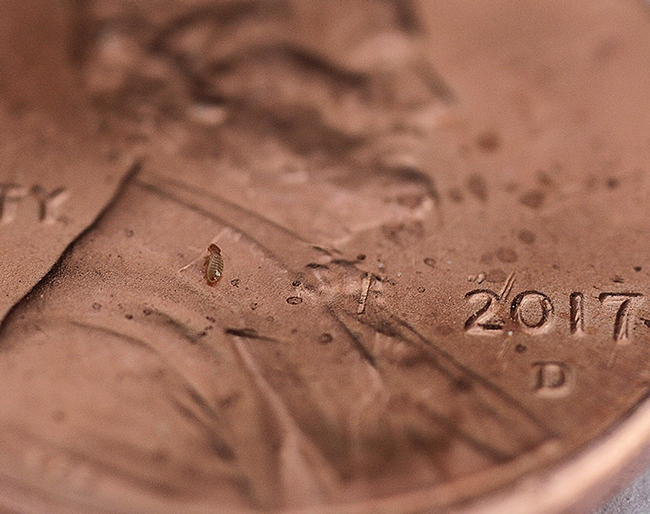
Find the booklouse! It's on this penny, magnified with the powerful Canon MPE-65mm lens. (Photo by Kathy Keatley Garvey)

Odds are that the flour, cornmeal and other stored products you buy in a grocery store contain insects parts or nearly microscopic insects. It's estimated that the average American unknowingly eats one to two pounds of insects or insect parts a year. (Photo by Kathy Keatley Garvey)
Of wasps and penny-farthings and holiday gifting
Quick, what do wasps share in common with penny-farthings and holiday gifting?
Umm, a t-shirt? Right, you nailed it!
If you're trying to find something "buggy" for your friends and family, then you'll want to take a look at the design that won the UC Davis Entomology Graduate Students' Association (EGSA) t-shirt contest.
"Hymenoptera on a Bike" is the work of Stacey Rice, a junior specialist in the lab of UC Agriculture and Natural Resources Cooperative Extension specialist Larry Godfrey, who is based at UC Davis. Rice researches Bagrada bugs (Bagrada hilaris), an invasive stink bug from Africa known for attacking cole crops, including broccoli, cabbage, collards, Brussels sprouts, cauliflower, kale, and mustard.
She is also an artist, and a very creative one at that. So when the EGSA announced its annual t-shirt contest, Rice decided to fuse art with science.
“I wanted to draw a penny-farthing, which is part of the UC Davis culture,” she said. "Then I wanted an insect that would be able to put its abdomen on the seat and have long enough legs to reach the pedals.”
An alumnus of UC Davis, Rice received her bachelor's degree in biological sciences with a minor in veterinary entomology in March 2015. Her goal is to attend graduate school and receive her doctorate, either in integrated pest management or forensic entomology.
She became interested in both fields after enrolling in a “behavioral ecology of insects” course taught by Edwin Lewis, associate dean for agricultural sciences in the College of Agricultural and Environmental Sciences, and professor and former vice chair, UC Davis Department of Entomology and Nematology.
The t-shirt, now available to the public on the EGSA's website, sold well at the Entomological Society of America's recent meeting in Minneapolis. (For more information on the T-shirt and other EGSA t-shirts available, access the online store at http://mkt.com/UCDavisEntGrad or contact EGSA treasurer Cindy Preto at crpreto@ucdavis.edu. All proceeds benefit EGSA.)
And wasps? Think #wasplove.
When Amy Toth, an assistant professor in the Department of Ecology, Evolution and Organismal Biology, Iowa State University, Ames, presented a seminar in May to the UC Davis Department of Entomology and Nematology, she covered her latest research on wasps and her enthusiasm was contagious.
We later asked her to list why she loves wasps (she coined the hashtag, #wasplove), and she obliged:
- They are pollinators
- They contribute to biocontrol of lepidopteran pests in gardens and on decorative plants
- They have been shown to carry yeasts to winemaking grapes that may be important contributors to the fermentation process and wonderful flavors in wine!
- They are the only known insect (Polistes fuscatus) that can recognize each other as individuals by their faces.
- They are devoted mothers that will dote on their young all day long for weeks, defending their families with fury.
- Their social behavior, in my opinion, is the most human-like of any insect. They know each other as individuals, and are great cooperators overall, but there is an undercurrent of selfishness to their behavior, manifest in nearly constant passive-aggressive interactions between individuals.
- They are artists. They make perfect hexagonal nest cells out of paper, which they make themselves out of tree bark + saliva.
- They are extremely intelligent. They're predators, architects, good navigators, and great learners. Among insects, they have large brains, especially the mushroom bodies (learning/memory and cognition area of insect brain).
- They are beautiful, complex, and fascinating creatures!
And to that list, we add No. 10: wasps are also photogenic!
Especially when they're riding a penny-farthing.
Author: Kathy Keatley Garvey
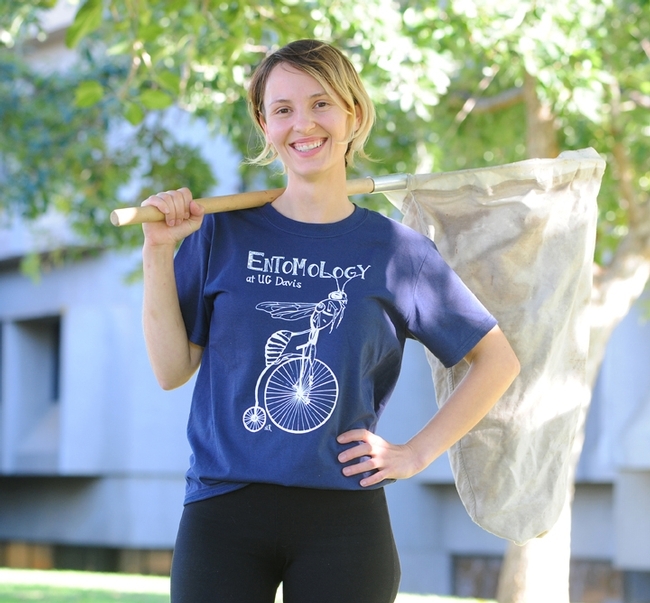
Junior specialist Stacey Rice of the UC Davis Department of Entomology and Nematology wearing the award-winning t-shirt that she designed. (Photo by Kathy Keatley Garvey)

A foraging European paper wasp, Polistes dominula. (Photo by Kathy Keatley Garvey)

